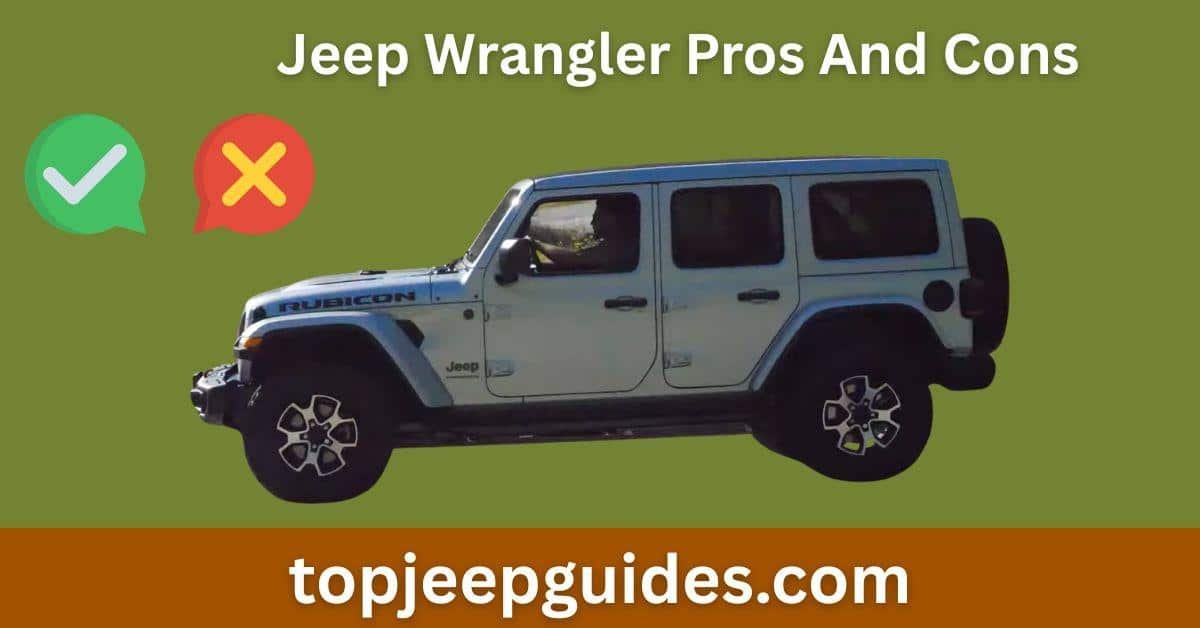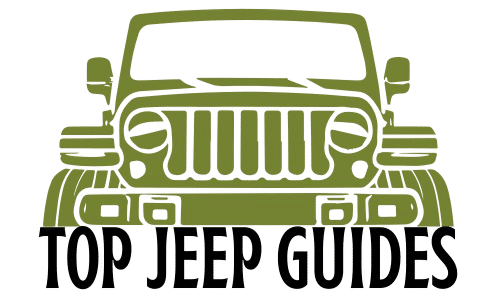Jeep Wrangler Pros And Cons (8 Pros and 5 Cons)

Imagine this:
You’re on a dusty trail, the roof is off, the doors are gone, and the mountains stretch out before you. The sun is shining. The wind plays with your hair. There’s no traffic, no deadlines—just freedom.
There’s something raw and thrilling about a Jeep Wrangler that no other vehicle offers.
But hold on.
Is this iconic beast really the right fit for you?
Let’s break it down—honestly and simply.
✅ Pros Of A Jeep Wrangler
The Jeep Wrangler is excellent for off-road performance, rugged design, and customization. Also, the Jeep Wrangler isn’t just a vehicle—it’s a symbol of independence and exploration. Built for the wild, this machine thrives on dirt trails and rocky climbs.
But here’s the catch:
Not everyone needs an adventure mobile for daily errands.
Here are the 8 pros of a Jeep Wrangler:
1. Unique Design And Build
You can spot a Wrangler from a mile away.
Boxy. Bold. Badass.
The removable doors and roof aren’t just gimmicks—they’re a lifestyle statement. Picture yourself driving down the beach with your elbows hanging out the side, music playing, and nothing between you and the elements.
But be honest: Is that your everyday life?
If your typical route involves school drop-offs and office parking garages, the rugged look might feel out of place.
2. Off-road Capabilities
This is where the Wrangler flexes.
High ground clearance. Heavy-duty axles. Trail-ready tires.
This vehicle isn’t afraid of mud, rocks, or rivers.
But—do you really need all that muscle if most of your time is spent in the city?
City roads might feel a bit too bumpy, and parking in tight spaces can be… challenging.
3. Customization Options
Think of the Wrangler as a blank canvas for car lovers.
Want a lift kit? Done.
Prefer matte black fenders? You got it.
Need winches and roof racks? Let’s go.
⚠️ But remember: Customization isn’t cheap.
What starts as a fun project can quickly become a money pit if you’re not careful.
4. Fuel Efficiency
Let’s keep it real:
The Wrangler isn’t exactly fuel-friendly.
With its rugged frame and thirsty engine, you’ll be stopping at gas stations more than you’d like—especially if road trips are your thing.
So ask yourself:
Does the adventure outweigh the cost?
5. Performance & Handling
Whether you love the hands-on control of a manual or prefer the ease of an automatic, the Wrangler offers both.
Choose from:
- V6 engine – rugged power for trail warriors
- Turbocharged 4-cylinder – balance of power and efficiency
- Diesel – torque-rich and towing-friendly
🚨 Just know: what it gives you in toughness, it takes away in smoothness.
6. Interior And Comfort
Rugged outside doesn’t mean rough inside.
- Spacious cabin
- Durable materials
- Modern tech (Uconnect, Apple CarPlay, premium sound)
Is it luxury? No.
Is it solid and dependable? Absolutely.
7. Cost & Maintenance
💵 Purchase Price
Starts around $30K–$50K depending on the model.
Expensive? Maybe. But the lifestyle it brings is priceless—for the right person.
🛠️ Maintenance
Off-road fun = more wear and tear.
Oil, brakes, suspension… keep a buffer in your budget.
📄 Insurance
Higher than average. Why?
Because Wranglers like to play rough, and insurance companies know it.
8. Jeep Wrangler In Pop Culture
You’ve seen it.
Jurassic Park.
Music videos.
Instagram reels with sunsets and surfboards.
The Wrangler isn’t just a car—it’s a cultural icon.
It stands for rebellion, freedom, and going wherever the road—or the lack of it—takes you.
Cons Of A Jeep Wrangler
Here are the 5 cons of a Jeep Wrangler:
1. Fuel Efficiency
The issue:
Jeep Wranglers are not known for their MPG. Most models average 17–25 miles per gallon, depending on engine type and driving conditions.
Why does it happen:
- Boxy design = poor aerodynamics
- Heavy-duty 4×4 system = more weight
- Off-road tires = increased rolling resistance
Impact:
If you’re driving your Jeep Wrangler long distances or commuting daily, expect frequent gas station stops and higher fuel expenses compared to other SUVs or sedans.
🔎 Good to know: Turbocharged or hybrid models improve this a bit, but don’t expect Prius-level savings.
2. Ride Comfort
The issue:
The Wrangler’s ride can be stiff, bouncy, and less refined, especially on smooth city roads or highways.
Why does it happen:
- It uses solid front and rear axles, great for off-road articulation but not for comfort.
- Suspension is tuned for rough terrain, not plush city cruising.
Impact:
You’ll feel every bump and pothole, especially in earlier or base models without upgraded suspension.
🚫 Not ideal if you value a soft, quiet, car-like ride.
3. Limited Cargo Space
The issue:
Even the 4-door Unlimited model has less cargo space than most midsize SUVs.
Why does it happen:
- Off-road design prioritizes ground clearance and durability over interior volume.
- 2-door models have even less space, making weekend trips or grocery hauls tricky.
Impact:
If you often travel with gear, groceries, or luggage, you’ll need to pack smart—or add a roof rack or cargo carrier.
🔄 Seats fold down, but space remains limited for bulkier items.
4. High Noise Levels
The issue:
Jeep Wranglers are louder than average vehicles, especially at higher speeds.
Why does it happen:
- The boxy shape increases wind noise.
- Soft-top models let in more road and wind sounds than hardtops.
- Off-road tires often generate more road noise.
Impact:
Expect a louder cabin, particularly during highway driving. Conversations may require raising your voice, and audio systems need to work harder.
🛠️ Upgrading to a hardtop, insulating the cabin, or using quieter tires can help—but it adds cost.
5. Cost of Ownership (Maintenance & Insurance)
The issue:
Wranglers are more expensive to maintain and insure than the average SUV.
Why does it happen:
- Off-roading = more wear and tear (suspension, axles, drivetrain)
- Custom parts = higher repair costs
- High risk for damage increases insurance premiums
Impact:
Expect:
- More frequent alignment checks, suspension repairs, and tire replacements.
- Higher insurance quotes, especially for younger or new drivers.
- Premium parts and accessories if you plan to modify or upgrade.
💡 Tip: Budget an extra cushion each year for maintenance—especially if you go off-road often.
Comparing Models
| Model | Best For |
|---|---|
| 2-Door | Solo adventurers, narrow trails |
| 4-Door | Families, gear haulers |
| Sport | Budget-conscious, daily driving |
| Rubicon | Hardcore off-roaders |
| Sahara | Comfort + capability blend |
Who Should Buy A Jeep Wrangler?
The Adventurer
Love camping, hiking, or trail driving? This is your dream ride.
The Outdoor Enthusiast
You carry gear, hit rough roads, and live for the weekends.
The Style Seeker
You want a vehicle that turns heads and makes a statement.
The Practical Family
Yes, it can work for families too—just consider the 4-door with safety features.
💬 Frequently Asked Questions
What Are The Benefits Of Owning A Jeep Wrangler?
Owning a Jeep Wrangler means you get excellent off-road ability, a classic rugged look, customizable features, removable doors and roof for versatility, strong resale value, and a supportive enthusiast community.
Is The Jeep Wrangler Fuel-efficient?
No, the Jeep Wrangler is not known for fuel efficiency. It prioritizes performance and off-road capabilities over fuel economy. The mileage is around 17–25 MPG, depending on the model and engine.
How Reliable Is The Jeep Wrangler?
The Jeep Wrangler is mostly reliable but may have occasional problems. Regular maintenance is important. Its off-road design can affect everyday comfort, but owners value its durability despite small mechanical issues.
What Are Common Issues With Jeep Wranglers?
Common Jeep Wrangler problems are roof leaks, electrical faults, transmission issues, and rust in older models. Regular maintenance helps reduce these. Despite this, many owners enjoy owning one.
Final Thoughts
The Jeep Wrangler isn’t for everyone.
But for the right person, it’s everything.
✔️ Bold
✔️ Capable
✔️ Iconic
But also:
❌ Noisy
❌ Bumpy
❌ Thirsty
So… what drives you?
Is it the call of adventure—or the ease of city comfort?
Take a moment.
Picture yourself behind the wheel.
Are you ready to live the Jeep life?






